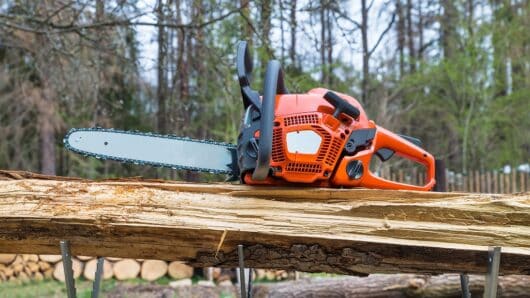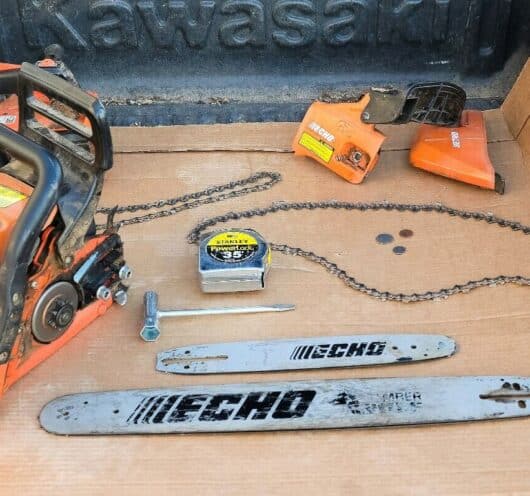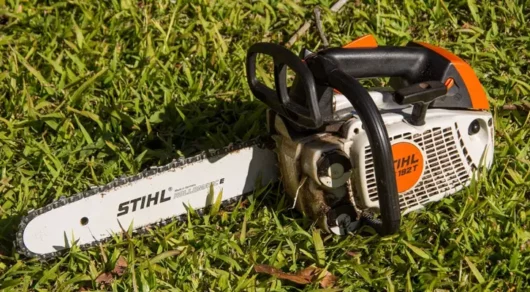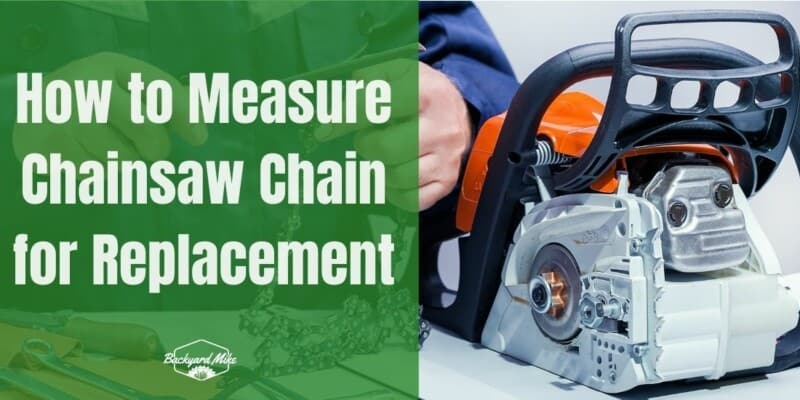Are you looking to replace your chainsaw chain, but don’t know where to start? Measuring your existing chain correctly is the first and most important step in finding the right replacement. This article will provide a step-by-step guide to help you measure your chain quickly and accurately. With a few simple tools, you can have the appropriate chain in hand in no time. Keep reading to learn more!
Overview of chainsaw chains
Chainsaws have become powerhouses in both professional and home landscaping. These machines simplify everyday tasks and make heavy-duty cutting tasks a breeze. However, like all power tools, even they require maintenance, replacement parts, and more, including the replacement of chainsaw chains.
There is nothing worse than a dull chain when you’re about to work with your chainsaw. Professionals sharpen the chainsaw chains after every use. Like any other component, your chainsaw’s chain will ultimately wear out and must be replaced. When it’s time to replace the chainsaw chain, some may find it complex if they don’t know where to start. This is especially the case if you’ve not done something like this before.
A great starting point would be to refer to the owner’s manual of your chainsaw. But what if you want to make different cuts? What if you want to replace the bar? What if you want to use a new chainsaw chain? This is where you’ll need to know how to measure chainsaw chain for replacement and other needs. Replacing the chainsaw chain on your chainsaw isn’t necessarily difficult. Once you understand different measurements, types, and sizes available, things will be much clearer. If it’s the right time to replace the chainsaw chain, and you aren’t sure where to begin with, then this blog is the right place for you to be.

How to measure the gauge of the chain?
A chainsaw chain is an important component of your chainsaw. It is responsible for cutting through trees and other objects, which makes it such a crucial part of this tool. The performance of the chainsaw chain will depend on its gauge, which is the thickness of the drive link, the part of the chainsaw chain that sits in the chainsaw’s bar groove.
What is a gauge?
The gauge of a chainsaw chain refers to the thickness of the drive links, the tooth-like underside of the chain that will fit in the guide bar. This measurement is critical as it’ll determine the chain’s compatibility with the chainsaw bar. The chain gauge will be measured in inches, and it’ll generally be in the manual or mentioned on the chainsaw itself. As it is difficult to measure the gauge accurately with a tape measure, you’ll require a vernier caliper to get an accurate measurement. There are four different gauge sizes – 0.043, 0.50, 0.058, and 0.063. The lower sizes tend to be the most common.
If the gauge of the chainsaw chain is too small, it won’t fit the bar. Meanwhile, if it is too large, it will not sit in the bar’s groove properly. The gauge of the chain will also affect the chain’s durability and strength, and it can heavily influence the cutting performance of the chainsaw.
Measuring the gauge of the chainsaw chain
Measuring the gauge of a chainsaw chain is a rather simple process and doesn’t require many specialized tools. Here are some of the steps that you will need to follow –
Step 1: Remove the chain from the chainsaw
The first step would be to remove the chain from your chainsaw. You can do so using a screwdriver for loosening the nuts that hold the bar and chain in place. After removing the chain, you should place it on a flat surface.
Step 2: Locate the drive links
The next step would be to locate the drive links of the chain. These are the parts of the chain that’ll sit in the bar’s groove and are responsible for powering the chain around the bar. Manually count the number of drive links on the chain and make a note of it. Laying the chain on a flat surface will make it easier for you to count the drive links.
Step 3: Measure the drive links
Using a vernier caliper or a ruler, you should measure the thickness of one of the drive links. You should ensure that you’re measuring the entire length of the drive links, including the flanges or any protrusions. Note down the measurement as well.
Step 4: Calculate the gauge
For calculating the gauge of the chain, you will have to divide the drive link’s thickness by two. For instance, if the drive link’s thickness is 0.063 inches, the gauge of the chain will be 0.0315 inches.
How to measure the pitch of the chain?
The pitch is another critical measurement for the chainsaw chain. The pitch is the distance between any three consecutive rivets in the chain, and it’ll determine the complexity of the chain with the chainsaw’s drive sprocket.
What is pitch?
As mentioned above, the pitch of a chainsaw chain is the distance between any three consecutive rivets in the chain. This measurement will be important as it’ll help in determining how the chain is fitting into the drive sprocket. The drive sprocket is the component of the chainsaw that powers the chain, and it has got a set pitch. The pitch of the chain needs to match the pitch of the drive sprocket for the chainsaw to properly function.
To find out the pitch measurement, you will require a tape measure. If you want the correct size, you should first count three rivets on the chain. Then, you will have to measure how far the rivets are from the center points. Then, divide the number by half to get your size. For instance, three rivets measuring around ½ an inch will give you ¼ inch after they are divided by 2. You should ensure that you’re checking the chainsaw and the owner’s manual for the measurements, as they’re either mentioned in the manual or on the chainsaw itself.

Measuring the pitch of a chainsaw chain
Measuring the pitch of a chainsaw chain is a rather simple process that needs a measuring tape or a ruler. Here are the steps that you will need to follow –
Step 1: Locate the rivets
The first step would be to locate the rivets on your chainsaw chain. These are the small metal pins that hold the links of the chain together. Count the number of rivets in any section of the chainsaw chain and make a note of it.
Step 2: Measure the distance
Using a measuring tape or ruler, you should measure the distance between any three consecutive rivets. Make sure that you’re measuring from the center of the first rivet to the center of the third rivet. Note down the measurement in millimeters or inches.
Step 3: Convert the measurement
The measurement you’re taking will be the distance between any three consecutive rivets, which is half of the chain’s pitch. For determining the chain’s full pitch, you should multiply the measurement you’ve taken by two. For instance, if the distance between three consecutive rivets will be 0.5 inches, the pitch of the chain will be 1 inch.
Step 4: Verify the pitch
After you have measured the pitch of the chain, it’ll be important to verify that it matches the chainsaw’s drive sprocket’s pitch. You can find the pitch of the drive sprocket in the owner’s manual of your chainsaw or by contacting the manufacturer. If the pitch of the chain doesn’t match the pitch of the drive sprocket, you’ll have to replace the chain with one that is perfectly compatible.
How to measure chainsaw chain for replacement
Learning how to measure the chainsaw chain size will be a little tricky, but it isn’t that difficult. To find out the correct replacement chain, the users will require three numbers – the gauge, the pitch, and the number of links in the chain.
This information will either be in the owner’s manual or on some chainsaw bars. For instance, if you’ve got an Echo chainsaw with a 12-inch bar, it’ll mean that the bar is 12 inches long, the pitch is 3/8 inch, and the gauge is 0.050. If there is no printing on the bar, it’ll be simple to find out the measurements.
Step 1: Count the number of drive links
The size of the chainsaw chains will depend on the number of drive links. This is a step that could be tedious, but it isn’t complicated. If the bar doesn’t have the right information printed on it, you’ll need to count the drive links.
While it isn’t necessary, typing a string between the links and starting to count right after the string will make it easier to count the links without actually losing your place. Remember to make note of the total number.
Step 2: Find out the pitch
The rivets are responsible for holding the drive links. This also keeps them attached and serves as flexible points to allow the chain to bend as it travels around the guide bar. For finding out the chain’s pitch, you must measure the distance between the three rivets. Start off at the center of a rivet, pass the second, and end at the center of the third.
This measurement needs to be precise, so you must start at the end of a tape measure having a hook that floats. Start off at the one-inch increment of the tape measure. For instance, say that the distance between the rivets was 6/8 inch. When divided by 2, the final result will be 3/8 of an inch. In simple words, this means that the chain’s pitch is 3/8 inch.
Step 3: Use common coins for determining the chain’s gauge
The gauge on your chainsaw chain will be the thickness of the tips of the drive links. The simple and easy way of figuring out the chain’s gauge will be to use coins for determining the width of the groove on the chainsaw bar. Make sure you’ve got a quarter, a penny, and a dime in your pocket. One at a time, try to fit each coin into the groove on the edge of the bar.
The coin should ideally slide into the groove easily but snugly. For instance, the quarter might be too wide for some chainsaws to slide into the groove. The dime could be so narrow that it rattled around. The penny could be the perfectly nice, snug fit. This means that the correct gauge will be 0.058. Use these measurements for determining the gauge, depending on the coin that fits your gauge the best –
- Dime – 0.050
- Penny – 0.058
- Quarter – 0.063
Find the right size chain for your chainsaw
When it comes to chainsaws, the chain is definitely a vital component. Without the appropriate size chain, your chainsaw will not function properly and might even be dangerous to use. Finding the appropriate size chain for your chainsaw will be important to ensure that it is running smoothly and safely. Here is how to find the appropriate size chain for your chainsaw
Step 1: Determine the type of chainsaw chain you need
Before you can find the right size chain for your chainsaw, you will have to determine the type of chain you need. Chainsaw chains come in a wide variety of different styles, including full-chisel, semi-chisel, and low profile. Each chain style has unique features that make the chain suitable for specific cutting tasks. Full chisel chains are perfect for cutting hardwood, whereas low profile chains are better suited for light-duty tasks.
Step 2: Determine the length of the chain
The length of the chain is essentially the distance between the guide bar’s tip and the drive sprocket. To determine the length of the chain, you will have to measure the guide bar’s length. You should measure the distance from the tip of the bar to the body of the chainsaw. Add two inches to the measurements for determining the proper chain length. For instance, if the guide bar measures 16 inches, you’ll require an 18-inch chain.
Step 3: Determine the pitch of the chain
The pitch of the chain is essentially the distance between any three consecutive rivets in the chain. You’ll be able to determine the pitch of the chainsaw by measuring the distance between any three rivets and dividing this distance by two. Alternatively, you can find the pitch in the owner’s manual of your chainsaw.
Step 4: Determine the gauge of the chain
The gauge of the chain will refer to the thickness of the drive link, the part of the chainsaw chain that will sit in the chainsaw bar’s groove. For determining the gauge of your chainsaw chain, you could either refer to the owner’s manual or measure the thickness of a drive link using a vernier caliper.
Step 5: Purchase the correct chain
Once you have determined the type, pitch, length, and gauge of the chain that you need, it will be time to purchase the correct chain. You can either buy a chain from the manufacturer or purchase a third-party chain. If you’re going for a third-party chain, you should make sure that it is compatible with your chainsaw model and that it meets the manufacturer’s specifications.
What size chain do I need for my chainsaw?
There are limitless combinations of chainsaw chains with varying types, sizes, and features. When it comes time to replace your chain, you should be fully aware of what you need in your chainsaw chain. You must define your requirements and then carry out the measurements of the pitch, gauge, and number of drive links to ensure that you find the perfect fit for your chainsaw chain.
The owner’s manual will put you halfway through the process, as it’ll have most of the information and measurements. The owner’s manual for your chainsaw will list the type of chain you require as a replacement part. Knowing the model number of your chainsaw will help you find the correct replacement chain at your local hardware store. Many replacement chains will list the models of the chainsaw that fit on the packaging. The size of the chain isn’t the only consideration, as different types of chains will be best suited for different types of cutting.

Why you should never use the chainsaw chain with wrong measurements?
Using the wrong chain measurement on your chainsaw will lead to various problems, both for your chainsaw and your own safety. Chainsaws are extremely powerful and dangerous tools, and they’ll need the correct chain measurement for functioning correctly. Here are some of the reasons why you shouldn’t be using the wrong chain measurements for your chainsaw –
#1. Reduced performance
Using the wrong chain measurement on your chainsaw can result in reduced performance. The chain is largely responsible for cutting through wood, and if it’s too short or too long, it won’t cut efficiently. A chain that is too long, it’ll result in a loose chain, which could cause the chain to slip or jump off the bar. Meanwhile, a chainsaw chain that is too short won’t reach the end of the bar, which will mean that it won’t cut through the wood.
#2. Increased wear and tear
Using the wrong chain measurement on the chainsaw can also increase the wear and tear on your chainsaw. A chain that is too short or too long can cause excess friction between the bar and the chain. This will lead to a shorter lifespan for your chainsaw and the need for more frequent repairs or replacements.
#3. Safety hazards
Using the wrong chain measurements on your chainsaw could result in safety hazards. A chain that is too long could result in a loose chain, which will jump off the bar and become a dangerous projectile. A chain that is too short could result in a kickback, which can cause your chainsaw to recoil and potentially injure the user. In addition, a loose or tight chain could cause the chain to break, which can be very dangerous for the operator and bystanders.
#4. Decreased efficiency
Using the wrong chain measurement on your chainsaw can also result in decreased efficiency. A chain that is too short or too long will not cut through the wood efficiently, which could result in longer cutting times and increased fuel consumption. It can be particularly problematic if you’re using the chainsaw for professional or commercial purposes, as it could lead to decreased productivity and increased costs.
FAQs
What is the best way to measure my chainsaw chain for replacement?
The best way to measure a chainsaw chain for replacement is to measure its pitch, gauge, and length. The pitch is the distance between three consecutive rivets divided by two, and the gauge is the thickness of the drive link where the chain attaches to the bar. The length of the chain can be determined by measuring the number of drive links.
What information do I need to know in order to find the right size chain for my chainsaw?
In order to find the appropriate size chain for your chainsaw, you will need to know the make and model of the chainsaw, as well as the pitch, gauge, and length of the chain. You can find this information in the owner’s manual or on the chainsaw itself.
What is the difference between the gauge and the pitch of a chainsaw chain?
The gauge of a chainsaw chain is the thickness of the drive link where the chain attaches to the bar. The pitch is the distance between three consecutive rivets divided by two. The two measurements are necessary for determining the correct size chain for your chainsaw.


